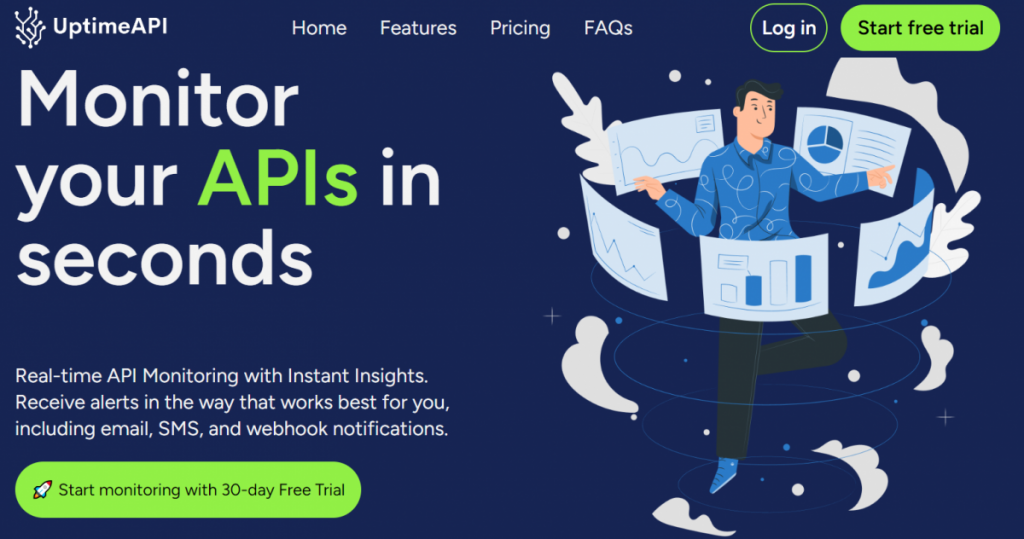In the realm of software development, robust and reliable APIs (Application Programming Interfaces) are the backbone of seamless application interactions. Ensuring the functionality and performance of these APIs is critical for delivering a positive user experience. API testing plays a pivotal role in achieving this goal, and with tools like UptimeAPI, developers can streamline their testing processes. In this article, we’ll explore the essentials of API testing and guide you on how to start using UptimeAPI for effective API testing. Additionally, we’ll delve into the intricacies of API responses to enhance your testing insights.
Understanding the Importance of API Testing

1. Ensuring Functionality
API testing verifies that the API functions as intended. It validates that the API endpoints return the correct data and perform the expected operations, ensuring that the core functionality of the software is intact.
2. Validating Data Integrity
API testing includes checking the integrity of data exchanged between the client and the server. This ensures that data is transmitted accurately and without corruption, a crucial aspect in maintaining data reliability.
3. Assessing Performance
Performance testing is an integral part of API testing. It involves evaluating how the API performs under different conditions, such as varying loads and response times. This ensures that the API can handle real-world scenarios without degradation in performance.
Getting Started with API Testing using UptimeAPI

Read More: Company profile APIUsage Cases
1. Sign Up for UptimeAPI
To begin API testing with UptimeAPI, sign up for an account on the UptimeAPI platform. The registration process is straightforward, providing you with the necessary credentials to access the tool.
2. Add API Endpoints for Testing
Once logged in, navigate to the dashboard and add the API endpoints you wish to test. Specify the endpoints, along with any required parameters, to configure your testing environment.
3. Set Up Testing Parameters
Customize your testing parameters based on your testing goals. Define the frequency of tests, specific testing scenarios, and any authentication requirements for the API endpoints.
4. Initiate API Tests
With UptimeAPI, initiating API tests is a seamless process. Activate the testing process, and UptimeAPI will start sending requests to the specified API endpoints at the configured intervals.
5. Monitor Test Results
UptimeAPI provides real-time monitoring and reporting of test results. Use the dashboard to track the outcomes of your API tests, including response times, status codes, and any potential errors.
Understanding UptimeAPI’s API Responses in Testing
To effectively leverage UptimeAPI for APIs testing, understanding the nuances of API responses is crucial. Here’s a breakdown of what to expect:
1. HTTP Status Codes
UptimeAPI uses standard HTTP status codes in its responses. A 200 status code indicates a successful test, while 4xx or 5xx codes signify errors. Incorporating these status codes into your testing analysis allows you to quickly identify and address issues.
2. Response Time Metrics
Response time metrics provide insights into the performance of your API. UptimeAPI includes response time information in its responses, enabling you to assess how quickly the API endpoints respond under different conditions.
3. Error Details
In case of errors, UptimeAPI provides detailed error information in the API responses. This includes error codes, descriptions, and timestamps, facilitating quick diagnosis and resolution of issues discovered during testing.
4. Historical Performance Data
UptimeAPI goes beyond real-time monitoring by storing historical performance data in its responses. This data allows you to analyze trends over time, identifying patterns and potential areas for improvement in your API.
Best Practices for Effective API Testing with UptimeAPI
1. Create Comprehensive Test Cases
Define clear and comprehensive test cases that cover various aspects of your API, including different endpoints, input scenarios, and error handling.
2. Utilize Automation for Repetitive Tests
Automate repetitive tests to streamline the testing process. UptimeAPI allows you to schedule tests at regular intervals, enabling automated testing without manual intervention.
3. Simulate Real-World Conditions
Replicate real-world conditions during testing. Vary the load on your API and assess how it performs under different levels of traffic to ensure scalability.
4. Integrate with Continuous Integration/Continuous Deployment (CI/CD) Pipelines
Integrate APIs testing into your CI/CD pipelines to ensure that testing is an integral part of your development workflow. This allows you to catch issues early in the development process.
Conclusion: Elevate Your APIs Testing with UptimeAPI
APIs testing is a crucial aspect of software development, ensuring that APIs function as intended and perform optimally. UptimeAPI provides developers with a user-friendly platform to conduct effective APIs testing, offering real-time monitoring and detailed insights into API responses. By following the steps outlined in this guide, developers can seamlessly integrate UptimeAPI into their testing processes, enhancing the reliability and performance of their APIs. Start your APIs testing journey with UptimeAPI and take a proactive approach to ensure the success of your software applications.

